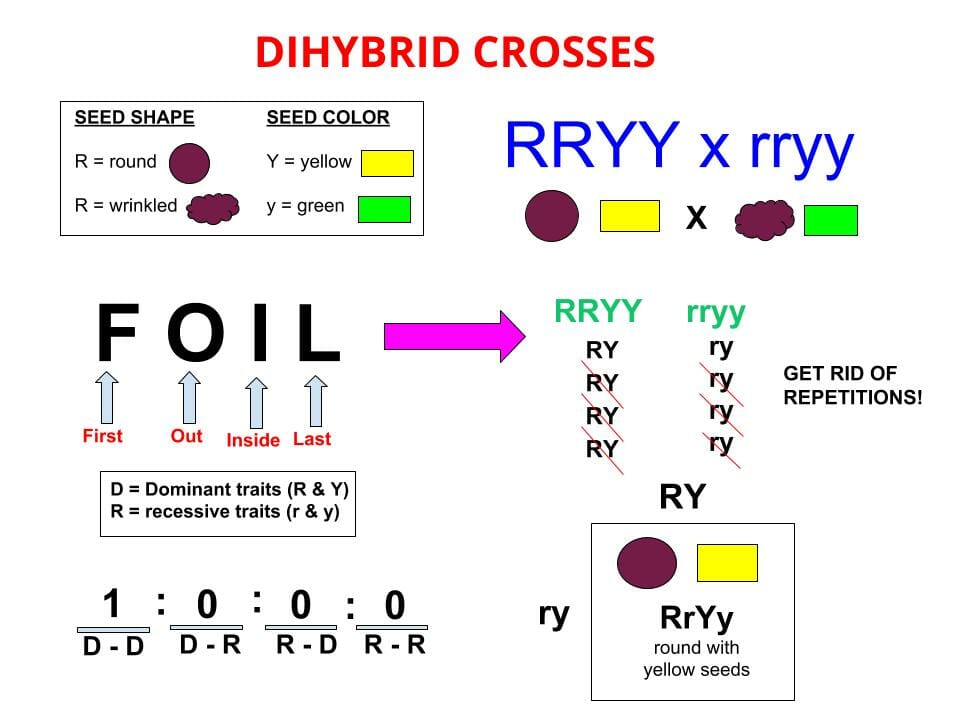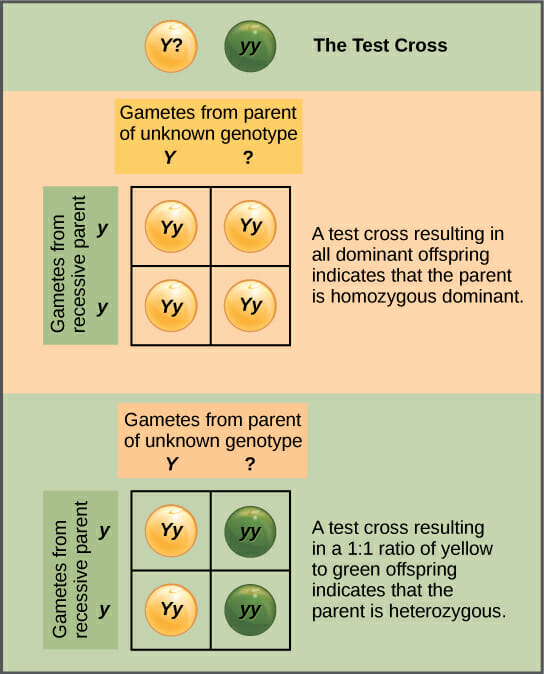Test Cross Definition
The test cross is an experiment first employed by Gregor Mendel, in his studies of the genetics of traits in pea plants. Mendel’s theory, which holds true today, was that each organism carried two copies of each trait. One was dominant trait, while one could be considered recessive. The dominant trait, if present, would determine the outward appearance of the organism, or the phenotype. Thus, Mendel became interested in the question of determining which organisms with the dominant phenotype had two dominant alleles, and which have one dominant allele and one recessive allele. His answer came in the form of the test cross.
The purpose of the test cross is to determine the genetic makeup of the dominant organism. Mendel wanted to do this so that he could be sure he was working with a dominant organism which was homozygous, or contained only dominant alleles. However, the phenotype alone doesn’t not tell you the genotype of an organism. The organism could be hiding a recessive, non-expressed allele. To find out what this unknown allele was, Mendel developed the technique of breeding this individual with a homozygous recessive individual for the same trait.
The phenotypic results of the offspring then tell you the genetic make-up of the original parents. The recessive phenotype parent is known to have two recessive alleles for the trait, otherwise the dominant trait would show. If the dominant phenotype parent has a recessive allele, this will be given to approximately half of the offspring. These offspring would receive a recessive allele from the other parents, and therefore be homozygous recessive. Thus, if any of the offspring from the test cross have the recessive trait, the dominant phenotype parent was actually heterozygous, having both a dominant and recessive allele.
If, on the other hand, the offspring all show the same dominant phenotype as the unknown parent, then the second allele the dominant phenotype parent has is also dominant. The recessive parent had to donate a recessive allele, either way. Thus, every offspring has at least one recessive allele. If none of the offspring show a recessive phenotype, it means that the dominant parent passed only dominant alleles to the offspring. This would make the unknown parent a homozygous dominant individual for that trait. In other words, the test cross is a genetic test which reveals the unknown genotype of dominant individuals. The test is interpreted through the number and type of offspring. Below are some common examples.
Test Cross Examples
Monohybrid Cross
The typical example of the test cross is the origin experiment Mendel conducted himself, to determine the genotype of a yellow pea. As seen in the image below, the alleles Y and y are used for the yellow and green versions of the allele, respectively. The yellow allele, Y, is dominant over the y allele. Therefore, in an organism with the genotype Yy, only the yellow allele is seen in the phenotype. Mendel had a yellow pea, and he wanted to know whether it was YY or Yy.
This was important to Mendel as it is to many seed producers and farmers today. The quality of a seed is determined by the plant it produces. A YY plant, if self-fertilized, would produce only yellow peas, in all of its offspring. There are many traits which are desirable to reproduce, and a homozygous plant is the obvious choice to do reproduce it with. However, in a dominant/recessive relationship, it is impossible to distinguish between a homozygous dominant plant (YY) and a hybrid, or heterozygous plant (Yy). Both would produce yellow seeds. However, if the Yy plant self-fertilizes, there is a chance of an offspring with the (yy) genotype, which would make green peas. Mendel sought to sort this out once and for all, so he devised the following test cross.
Mendel bred the unknown yellow pea (Y?) with a green pea, being homozygous recessive (yy). The chart below shows the two possible outcomes of the test.
Either the offspring would be all yellow, or around half of them would be green. This is based on the results of the two Punnett squares shown. The top square shows the results if the unknown yellow pea is (YY). In this case, the pea has no recessive allele to pass to the offspring. Therefore, 100% of the offspring receive one Y allele and one y allele, making them all yellow.
In the second case, if the unknown yellow pea has the genotype Yy, half of the offspring will receive this allele. The other allele will be from the green pea, and will also be a green allele (y). In this case, half of the offspring will produce green peas. The test cross itself occurs when the two plants are bred together, by taking pollen from the recessive plant, and carefully placing it on the flowers of the yellow pea plant. Mendel would then carefully rear all of the beans produced (which would be yellow) into plants of their own. The color of peas that these plants produced would determine the genetics of the original plant, which produced the yellow (Y?) seeds.
Dihybrid Test Cross and Beyond
This simple model works well for a single trait, but it can easily be expanded to encompass more traits. The dihybrid cross is a cross which looks at the cross of two separate traits with different alleles. Sticking with the pea color example, we will add a trait to the cross, let’s say shape. Peas can either be round and plump, or wrinkly. Round peas are dominant, created by the (R) allele. Wrinkled peas are only found in homozygous recessive individuals (rr). The following chart shows how to calculate the results of test cross. (Note that wrinkled seeds should have the r allele).

In the case shown, this is a test cross involving an individual which is homozygous dominant for both traits, with the all recessive test cross individual. This test cross individual will always have all recessive traits, as it allows for immediate detection of the genotype based on the offspring ratio. The image describes using the FOIL method of determining all the possible outcomes. On the first genotype, you would pair the first allele of each gene (RY), then the outside pair (also RY). After carrying this procedure out, you have all the possible gametes formed from each parent. Eliminate the repetitive pairs, and you have the only relevant pairs. In this case, all of the offspring are going to be RrYy. This would tell us that the parent was homozygous dominant for both traits.
If the first parent was heterozygous for both traits, the ratio of phenotypes would look much different. In this case, the first parent would be (RrYy). Using the FOIL method, you arrive at 4 possible gametes from the heterozygous parent: RY, Ry, rY, and ry. Combined with the single gamete type produced by the test cross parent, you can get 4 possible genetic combinations. These are RrYy, Rryy, rrYy, and rryy. The ratio on the bottom would be 1:1:1:1.
Thus, if you had a plant which produced round and yellow peas, but knew nothing else about it, you could put it through a test cross with a wrinkled green plant and know, for certain, the genotype of the original plant. While Mendel was limited in his day, the math of these crosses can be analyzed by computers much faster than humans can fill out Punnett squares. Thus, any number of traits can be analyzed by complex functions, with simple inputs such as color and shape. This has taken much of the guesswork out of genetics. However, many genes do not function by simple dominant/recessive relationships, and are controlled by much more complicated mechanisms.
Quiz
1. What is the purpose of a test cross?
A. Determine the genotype of an unknown plant
B. Produce “true-breeding” offspring
C. Both
2. You perform a test cross on some hamsters. You want to know if your brown hamster carries the allele for albinism, a recessive mutation which causes no pigment production. Normal hamsters are BB, and recessive hamsters (bb) have albinism. (Bb) hamsters simply carry the allele, but are still brown. When you breed your hamster (B?) with an albino hamster (bb), you get the following results: 4 brown hamsters and 4 albino hamsters. Does your hamster carry the albino allele?
A. Yes
B. No
C. Impossible to determine
3. Someone has claimed you are the offspring of the mailman! To uphold your mother’s nobility, you will use a hypothetical test cross. The mailman is blood type AB. Your mother is blood type O (OO). You are blood type O. Which of the following arguments will set the record straight?
A. The mailman was just being friendly
B. If the mailman is AB, he would have to donate an A or B allele to the offspring
C. See, I’m simply an EXACT replica of my mother!
References
- Hartwell, L. H., Hood, L., Goldberg, M. L., Reynolds, A. E., & Silver, L. M. (2011).Genetics: From Genes to Genomes. Boston: McGraw Hill.
- Lodish, H., Berk, A., Kaiser, C. A., Krieger, M., Scott, M. P., Bretscher, A., . . . Matsudaira, P. (2008). Molecular Cell Biology (6th ed.). New York: W.H. Freeman and Company.
- Widmaier, E. P., Raff, H., & Strang, K. T. (2008). Vander’s Human Physiology: The Mechanisms of Body Function (11th ed.). Boston: McGraw-Hill Higher Education.

